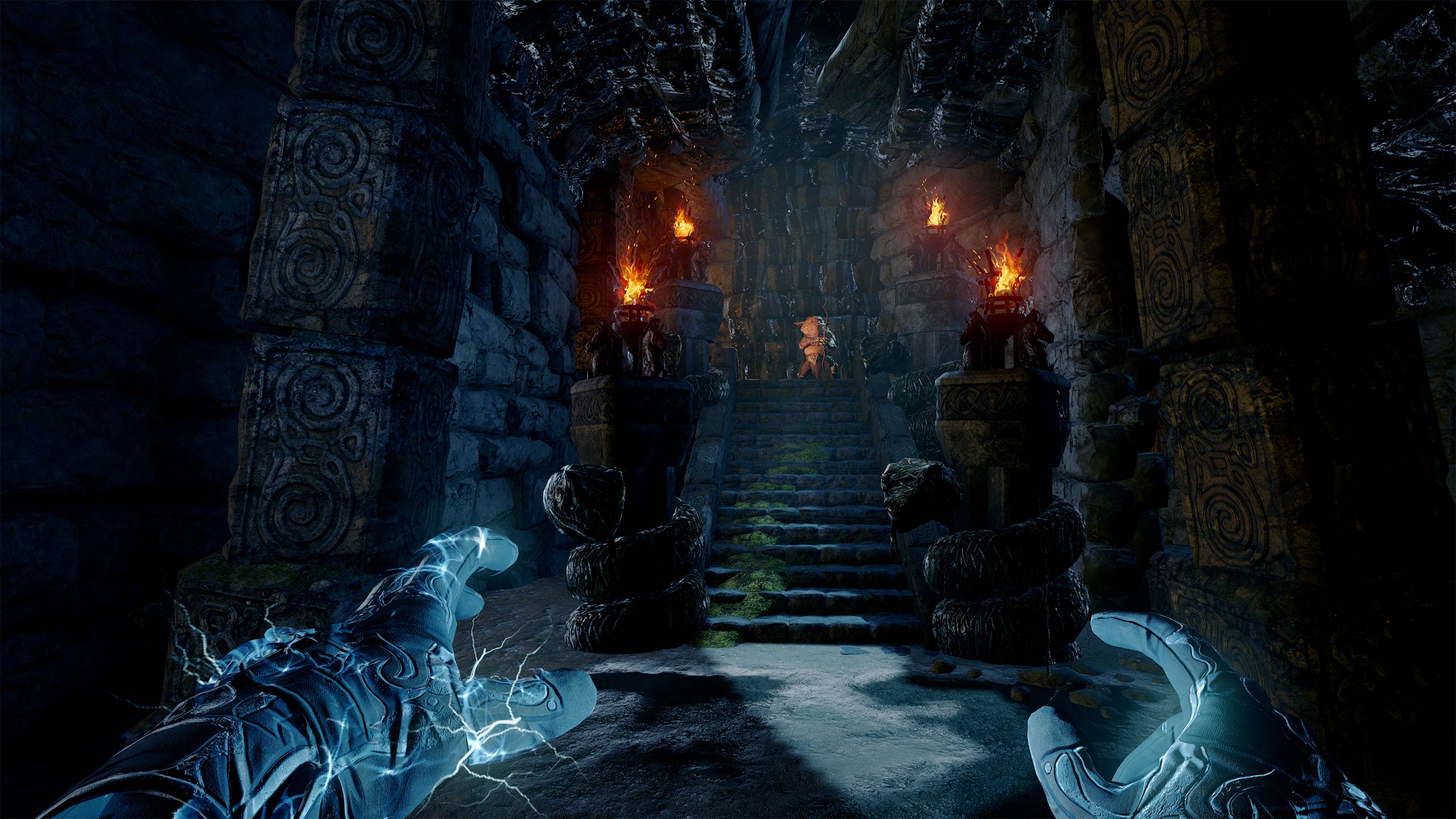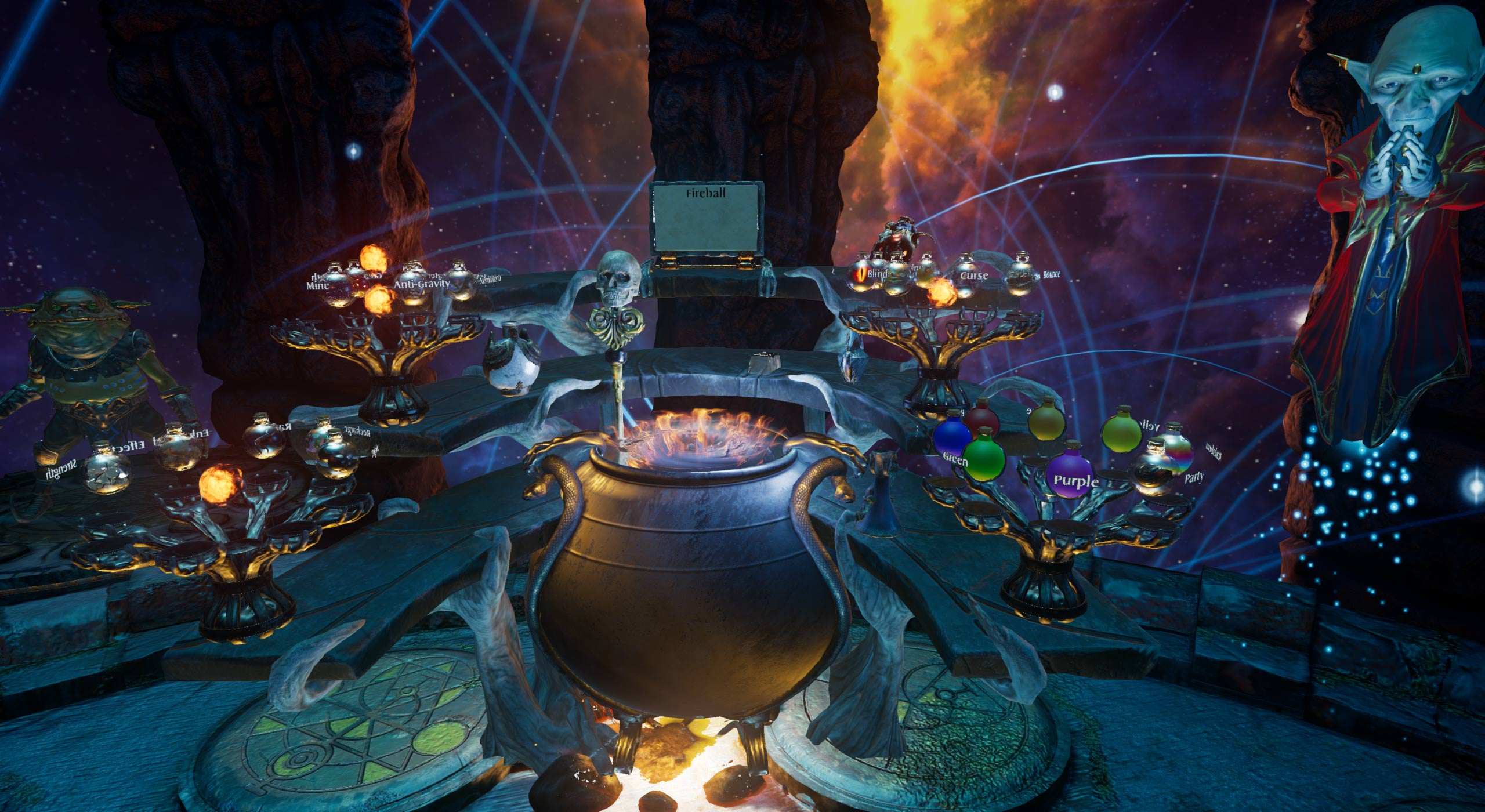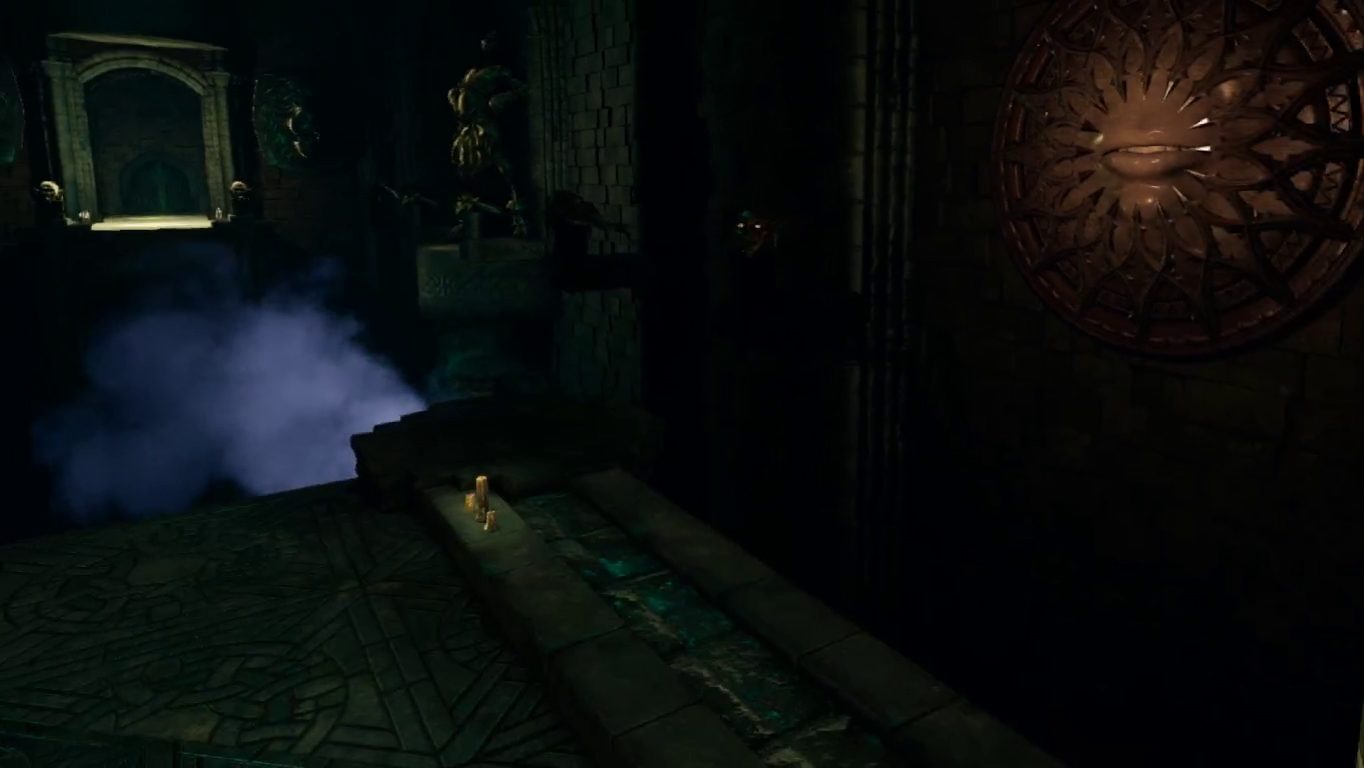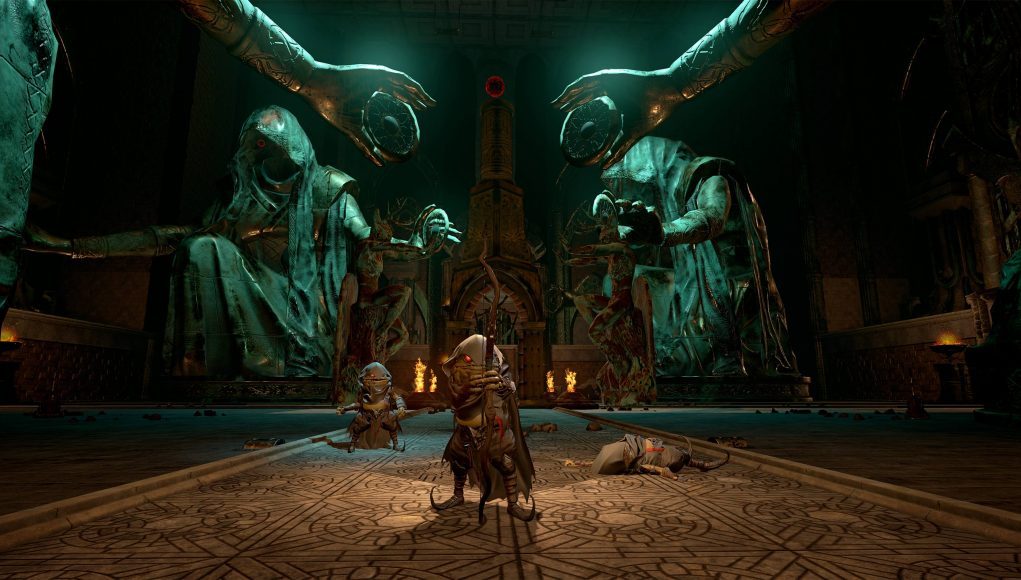Stepping into The Mage’s Tale, a first-person dungeon crawler RPG that puts you in the enchanted boots of an apprentice mage, is a bit like jumping into your own personal ’80s sword and sorcery flick. With elemental magic at the ready, you get to experience classic dungeon crawler stuff like exploration, spell crafting, puzzles, and battle against a number of monster types—and all of it in the immersive realm of VR. While at times a little rough around the edges, The Mage’s Tale is a charming throwback that vaults you head-first into a dank and mysterious universe of inXile’s other series, The Bard’s Tale.
The Mage’s Tale Details:
Developer: inXile Entertainment
Available On: Oculus Rift (Touch required)
Reviewed On: Oculus Rift
Release Date: June 20, 2017
Gameplay
The evil wizard Gaufroi has kidnapped your master, Mage Alguin. As his apprentice, it’s your job to get him back by finding his powerful fellow mages, a quest that takes you through ten dungeons where you’re confronted with various puzzles, traps, and monsters—where there’s always a chest that needs looting at the end.
Walking into a puzzle room usually elicits a hint from your Alguin’s familiar, a magical goblin whose name I can’t remember. For the purposes of this review, he shall henceforth be known as ‘smarmy turd’ (ST for short).

ST is a constant thorn in your side, and tends to tutorialize puzzles and generally point out the obvious. He does however make the dank dungeons placed before you a little less lonely, so I guess he’s got that going for him. When not tutorialized by ST, puzzles are explained by a changing cast of ever-present talking wall monsters, who offer riddles to help you along the way. Puzzles tend to be fairly simple, but because The Mage’s Tale offers so many varied types, you’ll always be on your toes figuring out the next one (if ST hasn’t spoiled it already, that is). You’ll find yourself fetching missing parts to puzzles, looking through magical orbs to locate important runes, cranking machines, freezing water in pipes so you can light a torch that’s being dowsed; the variations are so rich, that even the smarmiest of turds can’t ruin it for you.
When you’re not cranking weird machines and blowing out walls to reach hidden chests though, you’re probably blasting away at the world’s many monsters. Enemy types tend to be mostly ranged, like archers and mages, so they usually keep their distance allowing you to block with your arcane shield or plink away with your magical abilities. There are however a number of melee fighters to watch out for later in the game including shielded goblins and hammer-wielding giants. Enemies don’t have health bars, so you usually end up blasting away with whatever appears to work best on each enemy type.

To my utter dismay, dual-wielding is not a thing in The Mage’s Tale. Oh well.
A big personal attraction for me to the game is spell crafting. I would have loved to find ancient books filled with spells, but unfortunately crafting is done entirely through trial and error, as your cauldron will unhappily vomit out bad combinations, forcing you to start over again until you find something that works. Because there are more than 2 dozen ingredients and over a 100 combinations, you’ll spend plenty of time mixing and matching until you get that perfect lighting spell that has both impressive range, rips health from your enemies when they die and tosses out confetti on the monster’s dead body.

Chests usually offer some sort of magical ingredient you can use in crafting, be it base elemental spells like lighting/fire/wind/ice, or a modifier like poison, extra recharge, or triple shot. My absolute favorite part of opening chests isn’t receiving points for upgrades, or new magical reagents, but tossing them into the awaiting mouth of my teleporting frog-buddy, whose name was mentioned once and forgotten forever.
[gfycat data_id=”CoolPettyAmericancicada”]
Without revealing too much, the story line isn’t anything you wouldn’t find ripped from a Dungeon Master’s Guide, so don’t expect any great innovations in story telling here. But then again, that’s exactly you’re in for with The Mage’s Tale, a faithful classic that lets you fire lighting at wise-cracking goblins.
For those of you mashing ctrl+f and searching the article for ‘gameplay length’, you’ll see I finished in a little over 7.5 hours, a slight tick under the advertised 10+. I’m far from a completionist, so I don’t mind leaving the game’s many collectibles behind in the dark dungeons where they belong, so you may well spend 10+ hours collecting everything, not to mention trying your hand at mixing together ingredients to get better spells.
Combat can feel a little repetitive at times. This is dampened somewhat once you get a good number of reagents to add to your base spells and start to naturally rotate through different attacks instead of just picking the strongest one. Just like classic games of yore, combat can be a process of trial and error, so expect to get smashed a few times by a giant before you know his weak spot. To get a good idea of what combat looks like in The Mage’s Tale, check out the video below. And no, you can’t get a sword or any other melee weapon.
Immersion & Comfort
Relying on classic dungeon level design and an appropriate mix of irreverent campiness (a goblin told me to “kiss his ass”), it’s easy to like The Mage’s Tale, especially as it follows some well-established practices in RPGs that date back to the pencil and paper era of Dungeons and Dragons. Bringing those places to life, and in a grand way, is ultimately one of the coolest things about The Mage’s Tale. It’s truly a breathtaking adventure into the known unknown.
Despite this, one thing that I can’t quite get around is the game’s character animations. An otherwise good-looking game with a varied palette, awesome magical effects, and impressive architecture, The Mage’s Tale is blighted by its clunky and wooden characters, that when confronted in VR look just terrible. A competent swath of Scottish and English voice actors do their best to bring the characters to life, but I can’t shake the feeling that every NPC is actually chewing on a magically invisible potato.
[gfycat data_id=”DangerousLongBergerpicard”]
Another gripe is the game’s ‘force grab’. Striving to make your life easier by giving you a telekinetic powers and saving you from constantly bending over and letting you get to items just out of reach, actually activating the force grab it is somewhat of a pain. Instead of using the omnipresent gaze-based cursor to highlight objects, you actually select the item by pointing your finger at it, which is extremely fiddly. It doesn’t sound difficult to grasp at first, but I can’t count the number of times I waved my hands to no effect at a nearby bottle or mushroom. Also, force grab seems to take precedent over natural object interaction, and trying to lift open a chest or grab one of the many collectible monster cages without critically highlighting it first, usually means your hand will pass right through it without the slightest bit of recognition of intent. Because force grab is usually used during downtime from battles, its more of a constant annoyance than a game-breaking feature.

During battle however, the game’s UI is remarkably intuitive, giving you access to either a spell menu with 4 selectable elemental spells, or an arcane shield that lets you reflect incoming arrows and enemy magic. You can access these on the fly, and mix and match your attacks/defense to the best effect. Popping the menu open and quickly shooting out a flurry of different spells is just so gratifying.
To the dismay of some players, locomotion is teleportation only, and is done by one of two ways; you can select the teleport spot and potentially move farther (and quicker) using your right thumbstick, or use your left thumbstick for a shorter blink teleportation. Even in close, quick combat, I felt ultimately very comfortable using either method. A snap-turn (aka ‘VR comfort mode’) exists so people using a two-sensor setup can adjust themselves for optimal hand controller tracking. As someone who owns a two-sensor stock Rift/Touch setup, I would highly recommend getting a third for better coverage, because it seems I was constantly facing the wrong direction at crucial moments.
Comfort-wise, I was very happy with The Mage’s Tale, but once battles really popped off and multiple enemies force you to go mobile, you really start to buck up against the limits of the locomotion style. Snap-turning and teleporting at high-speed can start to feel like a bit of a slide show, and while it’s ultimately comfortable, it certainly dampens the immersion. I hate to think how much I missed in the dark corners of the game by spamming the far-teleport button.
inXile developer Brian Fargo says in a recent tweet that The Mage’s Tale will be available on other VR platforms in 12 months.







